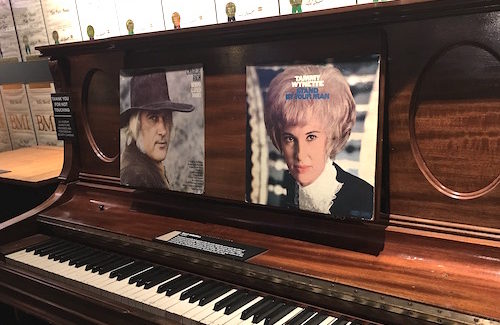‘Come see what you’ve heard’ at Musicians Hall of Fame
When Joe Chambers discovered that Jimi Hendrix’s apartment from his seminal years in Nashville had been razed, he decided that the Tennessee city should not lose another piece of music history.
“If people will make a trip to his grave in Seattle, why wouldn’t they go to see where he actually lived?” Chambers wondered. “That’s what really triggered me to having some kind of museum here.”
When another of the Nashville clubs where a young Hendrix performed was being renovated, Chambers tracked down the contractor and asked to salvage the basement stage. The contractor agreed, and Chambers used his memory of a famous photograph of Hendrix playing on that particular stage to guide the way.
Now the Musicians Hall of Fame honors the “Guitar God” with an exhibit featuring the rescued and restored stage, complete with a purple haze and Hendrix music.
“Long before Woodstock, Jimi Hendrix made a name for himself playing at the blues clubs here,” Chambers said. “In the early ‘60s, he was the lead guitarist for the house band at the Del Morocco.”
A guitar store owner, Chambers said the idea for the museum had been brewing for about a decade. “I want to show the diversity of what Nashville has done as a music center. It’s hard to put under one umbrella,” said Chambers.
With a slogan of “Come see what you’ve heard,” the museum opened in 2006 to honor the people who provide the sounds behind the songs. The attraction honors the players – whether stars, session pickers or sidemen – from all genres of music. Studio musicians are the names in the credits but not on the cover.
“I fell in love with Nashville the first time I came here,” said Chambers, who arrived in 1978 and wrote such popular songs as “Somebody Lied” for Ricky Van Shelton, “Old 8X10″ for Randy Travis,” and “Good Ones and Bad Ones” for George Jones.
“It’s unexplainable, but I knew this is where I needed to be,” Chambers said. “The more that I lived here, the more I learned about how many great musicians have been through here and started here. It’s really a secret.”
Museum curator played bass with popular band
Leading a tour through the museum located downtown on the first floor of the Nashville Municipal Auditorium, museum multimedia curator Jay McDowell paused before an exhibit and said, “This is my bass.”
At first, we thought McDowell was just saying that the exhibited instrument was one he would like to have owned. Then we saw the photo with the upright bass – “Smilin’ Jay McDowell” of BR5-49 fame.
The band – Gary Bennett, Don Herron, Chuck Mead, McDowell, and “Hawk” Shaw Wilson – garnered critical success and three Grammy nominations.
“The BR5-49 name came from the phone number that Junior Samples used on the old TV show ‘Hee Haw,’” McDowell said.
McDowell explained that the museum is divided into cities that have a history of recorded music – Detroit, Nashville, Memphis, Muscle Shoals, Los Angeles and New York. Studio musicians in those cities were famed for their ability to play whatever style of music was needed. They had nicknames like The Swampers, The A Team, The Funk Brothers and The Wrecking Crew.
The museum also has an interactive GRAMMY gallery where visitors have a chance to be on stage, to play musical instruments and to see what it’s like to record a song.
Many other items in museum collection
Other items in Chambers’ extensive collection – some items on loan, some donated, and some he bought – include:
• Lightning Chance’s bass, heard on all the early Everly Brothers albums, Conway Twitty’s “It’s Only Make Believe,” and Hank Williams’ last recording session, which brought “Your Cheating Heart.”
• Pete Drake’s steel guitar, played on Bob Dylan’s “Lay Lady Lay” and George Harrison’s album “All Things Must Pass.”
• Scotty Moore’s personal items from his long career in Elvis Presley’s band.
• Billy Sherrill’s cigarette-burned piano on which he composed country classics such as “Almost Persuaded,” “The Most Beautiful Girl,” and “Stand by Your Man.”
• Red Hot Chili Peppers’ snare drum, heard on their albums “Mother’s Milk” and “Blood Sugar Sex Magic.”
• Marshall Grant’s basses from Johnny Cash’s “Walk the Line” and “Ring of Fire,” along with the amp from “Folsom Prison Blues” and “A Boy Named Sue.”
• Uriel Jones’ drum kit.
• Eddie Willis’ guitars from countless Motown sessions.
• Ravi Shankar’s sitar used on the Beatles’ songs “Within You Without You.”
“The deal is that the instruments you see are the actual ones that you heard on a record,” Chambers said. “These are the unsung heroes, the people behind the records, behind the stars. You may not know Lightning Chance, but you will know the record he played on and will get to see his instrument.”
Members of the Musicians’ Hall of Fame are chosen by their peers and inducted annually.
“A lot of these musicians are getting towards the end of their careers,” Chambers said. “I’d like to honor them while they can enjoy it.”
For more information: Contact the Musicians’ Hall of Fame & Museum at (615) 244-3263, www.musicianshalloffame.com or the Nashville Convention & Visitors Corp. at (800) 657-6910, www.visitmusiccity.com
Story and Photos by Jackie Sheckler Finch


















View Recent Comments